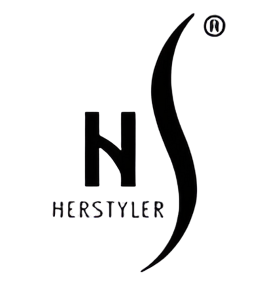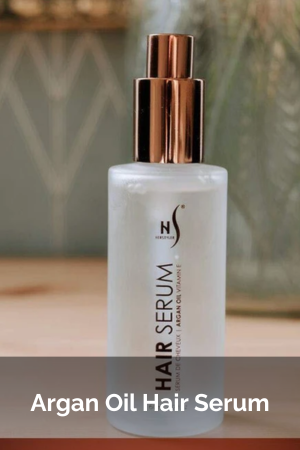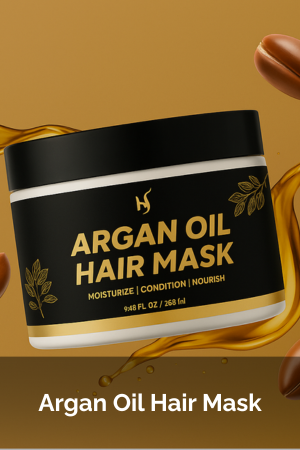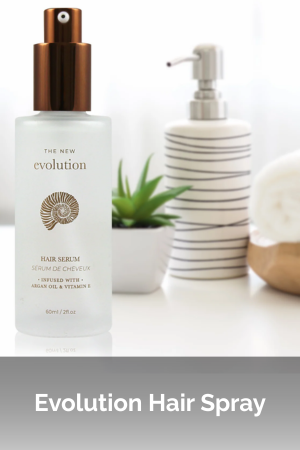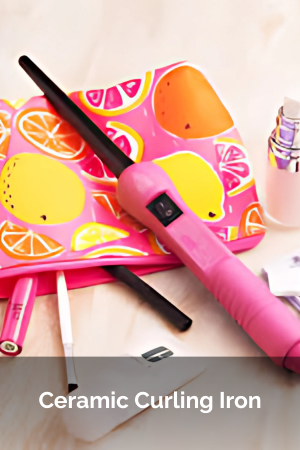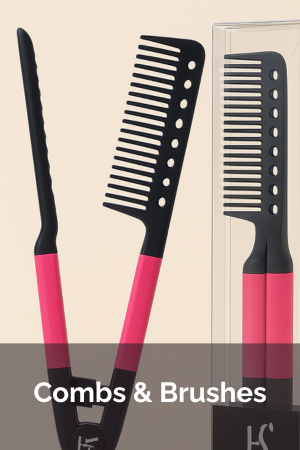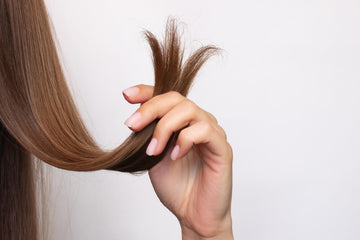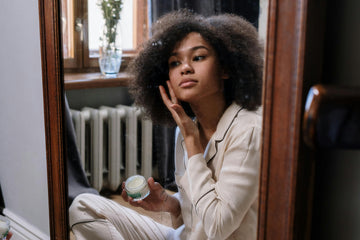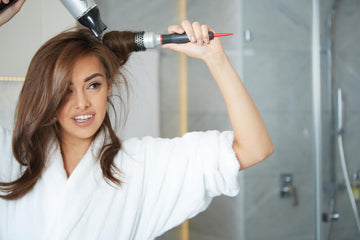While you may have the best intentions when it comes to your mane, it’s so easy to make mistakes. When done occasionally, these aren’t usually a big deal. However, if those small initial mistakes turn into habits, this is when you could end up seriously damaging hair and causing long-term harm.
Wondering if your hair habits are damaging your locks without you realizing it? Don’t worry – HerStyler is here to help! If you’re currently doing any of the following, it’s time to make some changes:
1) Skipping the Heat Protectant
 Heat styling is now more popular than ever. There are so many different styling tools out there, enabling you to manipulate your strands into salon-worthy styles in no time.
Heat styling is now more popular than ever. There are so many different styling tools out there, enabling you to manipulate your strands into salon-worthy styles in no time.
You’re probably already aware that heat styling isn’t doing your hair any favors. The more heat you use, the more you’ll be damaging your hair. This is why using a heat protectant is so important. These products form an extra barrier between your hair and your heated styling tools. This way, any burning that occurs will affect your heat protectant rather than your hair itself, saving your strands from the appearance of heat damage.
What type of heat protectant should you use? This is completely up to you. There are plenty of dedicated heat protectants out there but you could also opt for a hair serum. Not only will this provide that all-important barrier but a formula like the HerStyler Argan Oil Serum will also pamper your hair with a plethora of nutrients and conditioning compounds!
2) Using Excessive Heat When Heat Styling
 A heat protectant will go a long way in saving you from unintentionally damaging hair when heat styling. However, a heat protectant can only do so much. Subject your locks to intensely scorching temperatures and your heat protectant will quickly burn off, meaning that your hair will then receive the brunt of the heat damage.
A heat protectant will go a long way in saving you from unintentionally damaging hair when heat styling. However, a heat protectant can only do so much. Subject your locks to intensely scorching temperatures and your heat protectant will quickly burn off, meaning that your hair will then receive the brunt of the heat damage.
The best way to prevent this is to turn the temperature down when styling your hair. Many heated styling tools, such as the Colorful Seasons range from HerStyler, now come with an adjustable temperature feature, giving you full control over how much heat is emitted. Sure, if your hair is exceptionally thick and coarse, you’ll probably need to crank the heat up but, for everyone else, the maximum temperature is unlikely to be needed.
3) Washing Your Hair Too Often
People are often baffled when they first discover that over-washing their hair can cause more harm than good. It all comes down to how shampoos are designed to remove sebum from the hair. The sebum is produced by the scalp, after which it works its way down your strands. Its purpose is to condition your hair while also helping to keep it safe from environmental damage.
Washing your hair too often prevents this sebum from properly coating your strands. It won’t have enough time to reach the ends of your hair, especially if your locks are wavy or curly. This then leads to hair that’s dry, brittle, and easily damaged.
So, how often should you be washing your hair? Unfortunately, there isn’t a set answer. Instead, take it day by day. Avoid washing your hair unless it actually needs to be washed, rather than following a set hair-washing schedule. Allowing the sebum to do its job will make your hair look and feel much healthier.
4) Applying Conditioner to Your Scalp
Since shampoo is applied to the scalp, many do this with their conditioners too. However, this habit could be damaging hair more than you realize…
What’s the issue with conditioning your scalp? Simply put – your scalp doesn’t need it. Your scalp already produces plenty of sebum, which is essentially a natural conditioner. This means that the roots of your hair receive plenty of hydration and moisture. The ends of your hair, on the other hand, lack this moisture. This is the area that’s in desperate need of a conditioner.
If you condition your scalp, you run the risk of blocking the pores in your scalp. This can lead to damaged follicles, excessive sebum production, ingrown hairs, and more. To avoid this, concentrate your conditioner on the ends of your hair, making sure that it isn’t applied to your scalp.
5) Brushing Wet Hair
 Did you know that your hair is at its most fragile state when it’s wet? This is when it’s most prone to snapping and falling, making it important to be as gentle as possible with wet hair.
Did you know that your hair is at its most fragile state when it’s wet? This is when it’s most prone to snapping and falling, making it important to be as gentle as possible with wet hair.
Brushing your hair while it’s wet goes against this. Yanking a brush from root to tip will likely only leave you dealing with everything from breakages to split ends.
If you want to preserve the integrity of your locks, wait until your hair has dried before brushing it. If you need to do some de-tangling while your hair is damp, either use a wide-toothed comb or invest in a de-tangling brush. The HerStyler De-Tangle Brush would be a great choice!
6) Rubbing Wet Hair With a Towel
Another habit that’s known for majorly damaging hair is rubbing wet hair with a towel. Why is this so bad? Because, as you now know, wet hair is very delicate. Rough it up with a towel and you’ll be encouraging breakages, as well as frizz.
What’s the alternative when your hair is soaking wet? Gently wring it dry and then reach for a microfiber towel. They’re known for their exceptional absorption properties. Wrap the towel around sections of your hair and gently squeeze your strands. Your towel will soak up the majority of the moisture in no time, speeding up how long it takes to towel dry your hair while also saving you from damaging hair.
7) Blow Drying Your Hair When It’s Soaking Wet
While we’re on the topic of being gentle with wet hair…
Blow-drying your hair while it’s soaking wet is definitely not being gentle! All of that heat blasting onto your wet and fragile strands will only end up causing damage, even if you’ve applied a heat protectant first. The amount of time that it will take for your hair dryer to fully dry soaking wet strands means that your hair will be exposed to the heat for an extended period, which won’t do it any good.
Instead, wait until your hair is about 80% dry before tackling it with a blow dryer. Research also shows that to avoid damaging hair, your hair dryer should always be held about 15cm from your hair and moved continuously.
8) Repeatedly Tying Your Hair Back Tightly
From skin-tight top knots to slicked-back high ponytails, tight hairstyles are having their moment. There’s no denying how sleek and polished these looks can be but there’s also no getting away from the fact that they’re likely damaging your locks at the same time.
How? Because pulling your hair back tightly applies large amounts of tension to your scalp. When done regularly, this can lead to hair loss around the temples and hairline. Those who have fine or thin hair are particularly susceptible to this.
While you don’t need to completely avoid tight hairstyles, give your hair plenty of breaks from these too. Swap them out every once in a while for a low bun or braid – anything that doesn’t pull at your scalp will save you from damaging hair.
9) Spending Too Much Time in the Sun
It’s common knowledge that spending too much time in the sun spells bad news for your skin. However, did you know that your sun-worshipping habits could be harming your hair too?
UV rays are notorious for damaging hair cells. They accelerate damage and contribute to hair loss. They’ll also dry out your strands, leaving them parched, dull, and brittle. UV rays affect hair color too. Although the sun may leave you with hair that looks happily highlighted, that change in color is actually a sign of damage.
What can you do about this? Keep your mane protected by donning a hat or wrapping your locks in a scarf. A leave-in conditioner or a sunscreen for your hair can also help to fend off damage.
10) Sleeping on Cotton Pillowcases
While cotton may be a very comfortable material to lay your head on at night, your hair won’t feel the same way. Instead, each time your hair moves against a cotton pillowcase, friction is created. This not only contributes to damage but also leaves you more susceptible to frizz.
Silk or satin, on the other hand, are much gentler and smoother materials. They minimize friction, allowing your hair to easily glide over the fabric. They also don’t absorb as much moisture as cotton, which will help to keep your hair better hydrated.
11) Neglecting Regular Trims
For most people, split ends are inevitable. Sadly, there’s no way to repair split ends. Once that damage has occurred, the only way to stop those frays from unraveling even more of your lengths is to snip those split ends away.
Ideally, this should be done every couple of months. If you’ve gotten into the habit of leaving it too long in between trims, this simple change could make a world of difference to your strands.
12) Not Cleaning Your Heated Styling Tools
If you regularly use heated styling tools, cleaning them properly is essential. If you don’t, all of the dirt, sebum, product residue, dust, and more that gathers onto your tools will end up burning your locks each time you turn those tools on. They’ll also increase the chances of your styling tools snagging on your strands, causing even more damage.
To prevent this, keep your styling tools clean. This also includes your hair dryer and your hairbrush. Anything that touches your locks should be as clean as possible in order to prevent damaging hair.
Summary
As you can see, there are so many mistakes that can be made when it comes to your hair, all of which can end up causing large amounts of damage. The good news is that you’re now aware of all of these habits that could be harming your locks, meaning that a few simple changes to your routine could be all that you need to achieve hair that looks and feels stronger, thicker, and shinier.
Click here to pamper your hair with more bestselling products from HerStyler.

